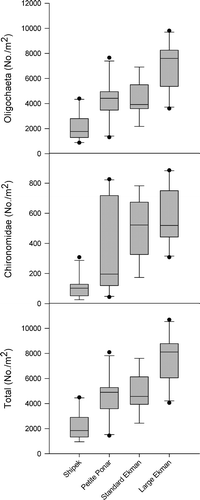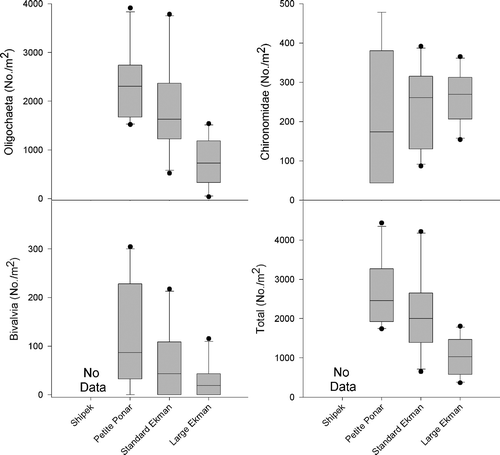Figures & data
Figure 1. Box plots of dominant macroinvertebrate and total macroinvertebrate densities (No./m2) from collections with each of the tested samplers in silt substrate at site 1. The top, middle, and bottom lines of each box represent the 75th percentile, median, and 25th percentile, respectively. The top and bottom bars represent the 90th and 10th percentiles, respectively, and the points represent outliers.

Table 1. Total benthos and dominant taxon mean (±SE) densities (No./m2) collected with different samplers at three sites during sampler efficiency testing. Logistical constraints prevented the collection of benthos with all samplers at all sites.
Table 2. Conversion factors determined from mean (±SE) densities collected with each sampler in silt substrate for all invertebrates combined and dominant taxa. A conversion factor was assumed to be 1.0 when there was no statistical difference (p ≤ 0.05) in mean density (No./m2) between samplers.
Figure 2. Box plots of dominant macroinvertebrate and total macroinvertebrate densities (No./m2) from collections with each of the tested samplers in sand substrate at site 2. The top, middle, and bottom lines of each box represent the 75th percentile, median, and 25th percentile, respectively. The top and bottom bars represent the 90th and 10th percentiles, respectively, and the points represent outliers.

Figure 3. Box plots of dominant macroinvertebrate and total macroinvertebrate densities (No./m2) from collections with each of the tested samplers in sand substrate at site 3. The top, middle, and bottom lines of each box represent the 75th percentile, median, and 25th percentile, respectively. The top and bottom bars represent the 90th and 10th percentiles, respectively, and the points represent outliers.
